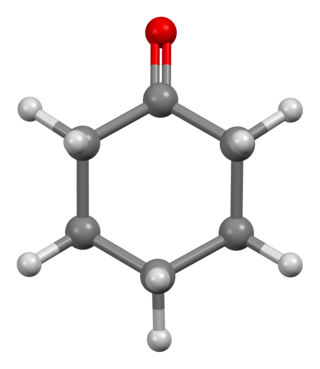Cyclohexanone
Chemical compound From Wikipedia, the free encyclopedia
Cyclohexanone is the organic compound with the formula (CH2)5CO. The molecule consists of six-carbon cyclic molecule with a ketone functional group. This colorless oily liquid[3] has a sweet odor reminiscent of benzaldehyde. Over time, samples of cyclohexanone assume a pale yellow color.[10]
| |||
| |||
| Names | |||
|---|---|---|---|
| Preferred IUPAC name
Cyclohexanone | |||
| Other names
oxocyclohexane, pimelic ketone, ketohexamethylene, cyclohexyl ketone, ketocyclohexane, hexanon, Hydrol-O, Sextone, K, Anone | |||
| Identifiers | |||
3D model (JSmol) |
|||
| ChEBI | |||
| ChEMBL | |||
| ChemSpider | |||
| DrugBank | |||
| ECHA InfoCard | 100.003.302 | ||
| EC Number |
| ||
| KEGG | |||
PubChem CID |
|||
| UNII | |||
CompTox Dashboard (EPA) |
|||
| |||
| |||
| Properties | |||
| C6H10O | |||
| Molar mass | 98.15 g/mol | ||
| Appearance | Colorless liquid[3] | ||
| Odor | Peppermint or acetone-like | ||
| Density | 0.9478 g/mL, liquid | ||
| Melting point | −47 °C (−53 °F; 226 K)[4] | ||
| Boiling point | 155.65 °C (312.17 °F; 428.80 K) | ||
| 8.6 g/100 mL (20 °C) | |||
| Solubility in all organic solvents | Miscible | ||
| log P | 0.81 | ||
| Vapor pressure | 5 mmHg (20 °C)[5] | ||
| −62.04·10−6 cm3/mol | |||
Refractive index (nD) |
1.447 | ||
| Viscosity | 2.02 cP at 25 °C[6] | ||
| Thermochemistry | |||
Std molar entropy (S⦵298) |
+229.03 J·K−1·mol−1 | ||
Std enthalpy of formation (ΔfH⦵298) |
−270.7 kJ·mol−1 | ||
Std enthalpy of combustion (ΔcH⦵298) |
−3519.3 kJ·mol−1 | ||
| Hazards | |||
| GHS labelling: | |||
   | |||
| Danger[7] | |||
| H226, H302, H305, H312, H315, H318, H332[7] | |||
| P280, P305+P351+P338[7] | |||
| NFPA 704 (fire diamond) | |||
| Flash point | 44 °C (111 °F; 317 K) | ||
| 420 °C (788 °F; 693 K) | |||
| Explosive limits | 1.1–9.4% | ||
| Lethal dose or concentration (LD, LC): | |||
LD50 (median dose) |
1200 mg/kg (cat, orally); 2362 mg/kg (rat, orally)[8] | ||
LC50 (median concentration) |
8000 ppm (rat, 4 hr)[9] | ||
LCLo (lowest published) |
4706 ppm (mouse, 1.5 hr)[9] | ||
| NIOSH (US health exposure limits): | |||
PEL (Permissible) |
TWA 50 ppm (200 mg/m3)[5] | ||
REL (Recommended) |
TWA 25 ppm (100 mg/m3) [skin][5] | ||
IDLH (Immediate danger) |
700 ppm[5] | ||
| Related compounds | |||
Related ketones |
Cyclopentanone, cycloheptanone | ||
Related compounds |
Cyclohexanol | ||
Except where otherwise noted, data are given for materials in their standard state (at 25 °C [77 °F], 100 kPa).
| |||
Cyclohexanone is slightly soluble in water and miscible with common organic solvents. Millions of tonnes are produced annually, mainly as a precursor to nylon.[11]
History and synthesis
Summarize
Perspective
The compound was discovered by Edmund Drechsel in 1888 among the products of AC electrolysis of slightly acidified water solutions of phenol. He named it hydrophenoketone and correctly suggested that phenol was first hydrogenated by electrolytic hydrogen to cyclohexanol, which he wasn't able to isolate, and then oxidized by electrolytic oxygen.[12][13]
Laboratory synthesis
Cyclohexanone can be prepared from cyclohexanol by oxidation with chromium trioxide (Jones oxidation). An alternative method utilizes the safer and more readily available oxidant sodium hypochlorite.[14][15]
Industrial production
Cyclohexanone is produced by the oxidation of cyclohexane in air, typically using cobalt catalysts:[11]
- C6H12 + O2 → (CH2)5CO + H2O
This process forms cyclohexanol as a by-product, and this mixture, called "KA Oil" for ketone-alcohol oil, is the main feedstock for the production of adipic acid. The oxidation involves radicals and the hydroperoxide C6H11O2H as an intermediate. In some cases, purified cyclohexanol, obtained by hydration of cyclohexene, is the precursor. Alternatively, cyclohexanone can be produced by the partial hydrogenation of phenol:
- C6H5OH + 2 H2 → (CH2)5CO
This process can also be adjusted to favor the formation of cyclohexanol.[11]
ExxonMobil developed a process in which benzene is hydroalkylated to cyclohexylbenzene. This latter product is oxidized to a hydroperoxide and then cleaved into phenol and cyclohexanone.[16] Therefore, this newer process without producing the acetone by-product appears attractive and is similar to the cumene process as a hydroperoxide is formed and then decomposed to yield two key products.[17]
Uses
Summarize
Perspective
The great majority of cyclohexanone is consumed in the production of precursors to Nylon 6,6 and Nylon 6. About half of the world's supply is converted to adipic acid, one of two precursors for nylon 6,6. For this application, the KA oil (see above) is oxidized with nitric acid. The other half of the cyclohexanone supply is converted to cyclohexanone oxime. In the presence of sulfuric acid catalyst, the oxime rearranges to caprolactam, a precursor to nylon 6:[11]
Other reactions
In addition to the large scale reactions conducted in service of the polymer industry, many reactions have been developed for cyclohexanone.
In the presence of light, it undergoes alpha-chlorination to give 2-chlorocyclohexanone.[18] It forms a trimethylsilylenol ether upon treatment with trimethylsilylchloride in the presence of base.[19]
It forms an enamine with pyrrolidine.[20]
Treatment with nitrosyl chloride and ethanol in sulfur dioxide gives the oximinecarboxylic ester:[21]
- (CH2)5CO + C2H5OH + NOCl → HON=CH(CH2)4CO2C2H5 + HCl
Illicit use
Cyclohexanone has been used in the illicit production of phencyclidine and its analogs[22] and is often subject to purchase restrictions, such as being listed on the Special Surveillance List in the US.[23]
Safety
Like cyclohexanol, cyclohexanone is not carcinogenic and is moderately toxic, with a TLV of 25 ppm for the vapor. It is an irritant.[11]
References
Wikiwand - on
Seamless Wikipedia browsing. On steroids.






